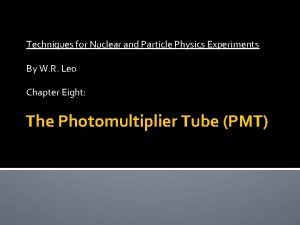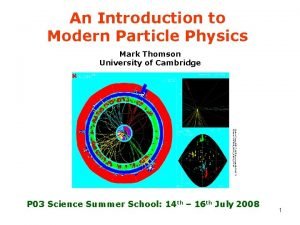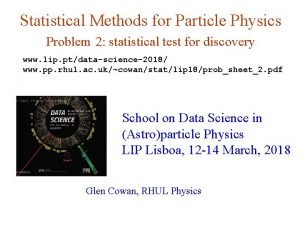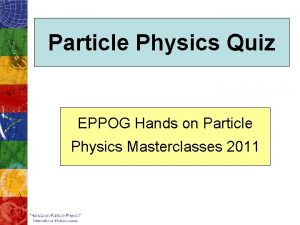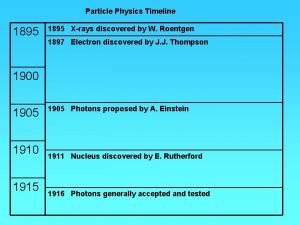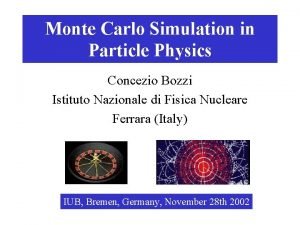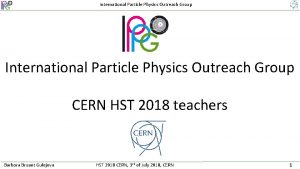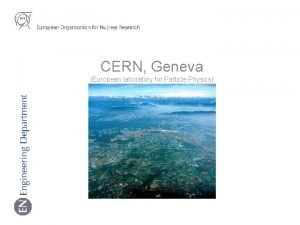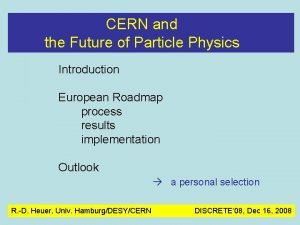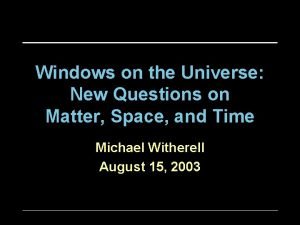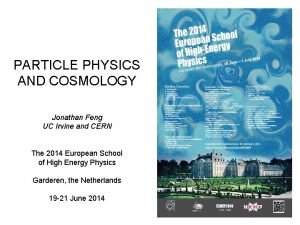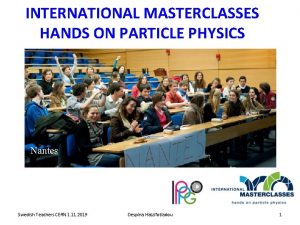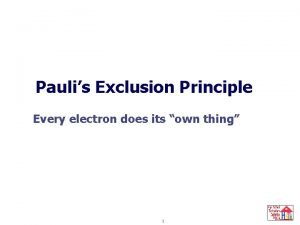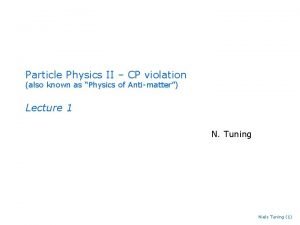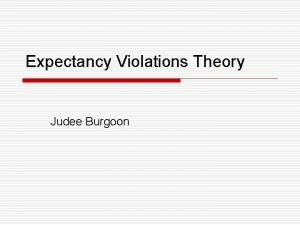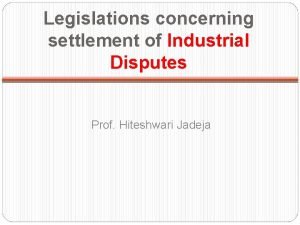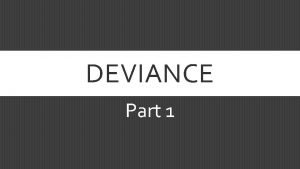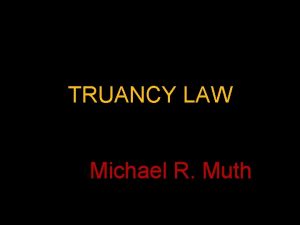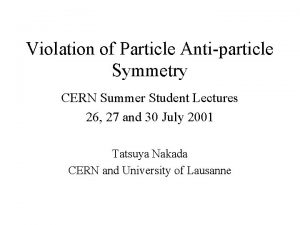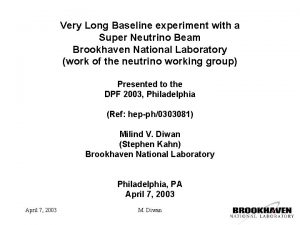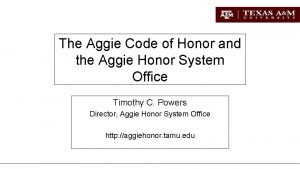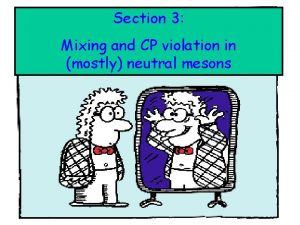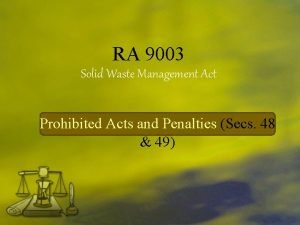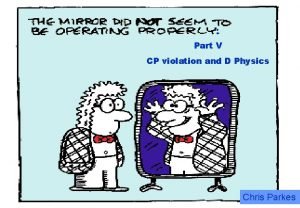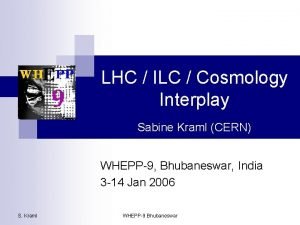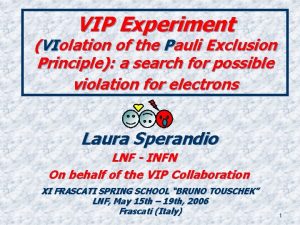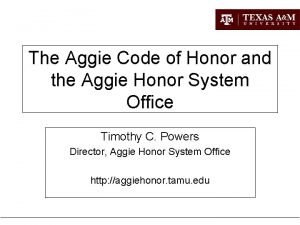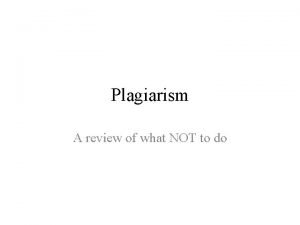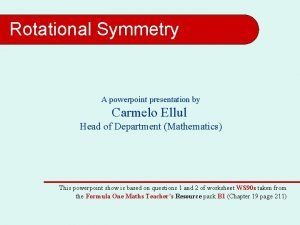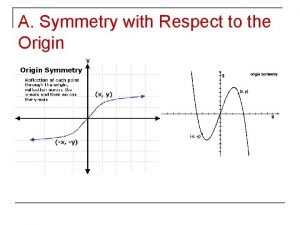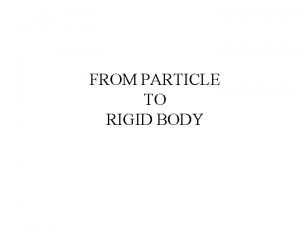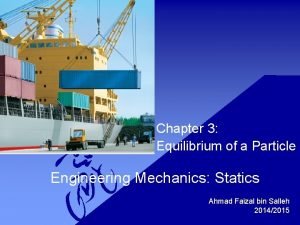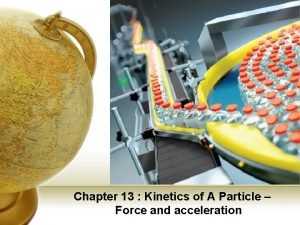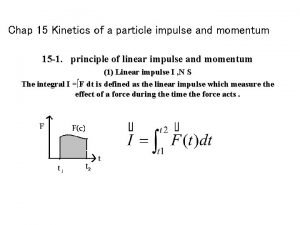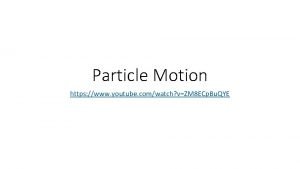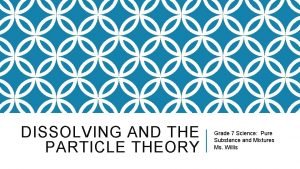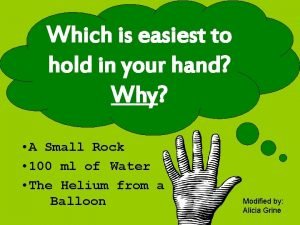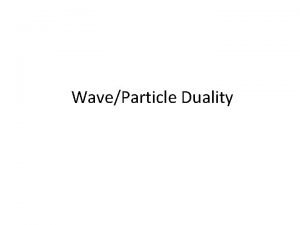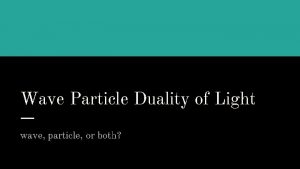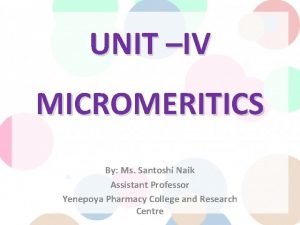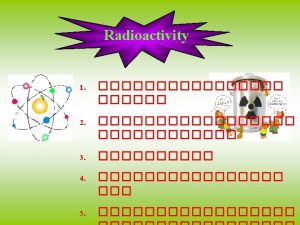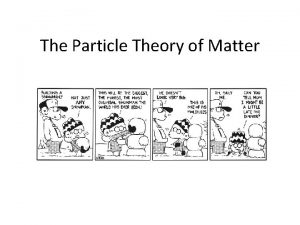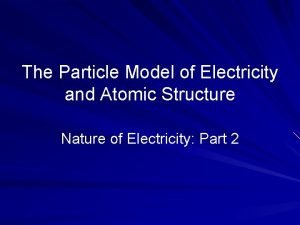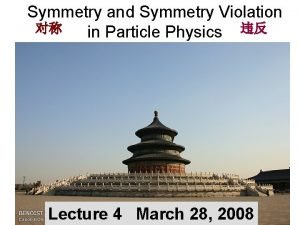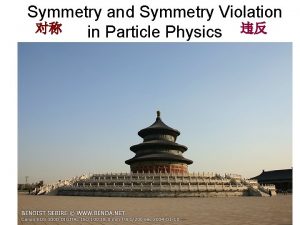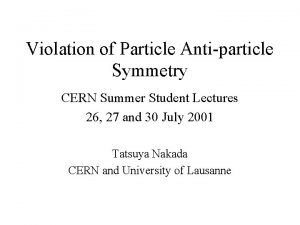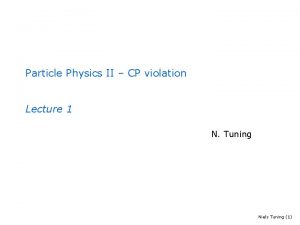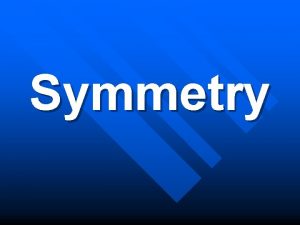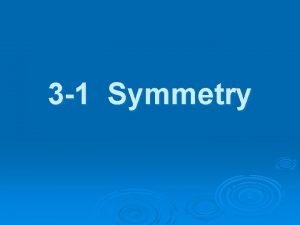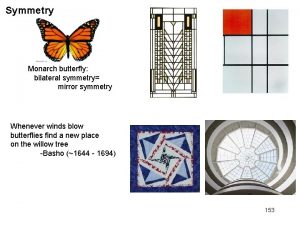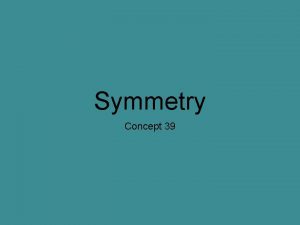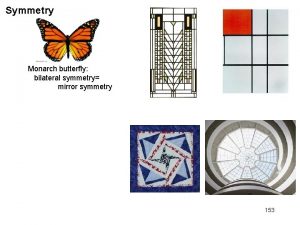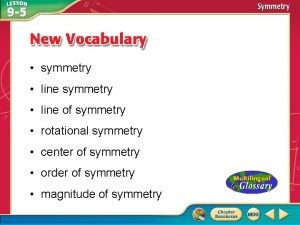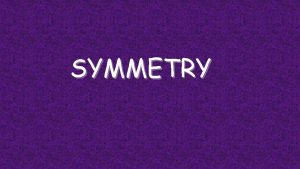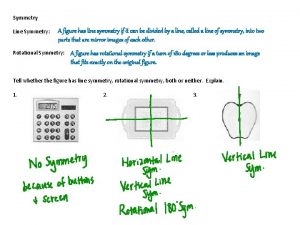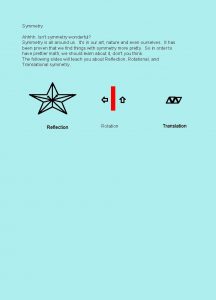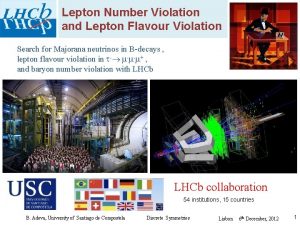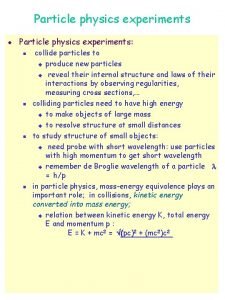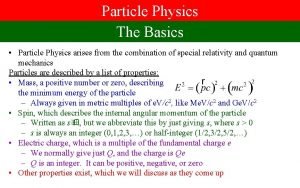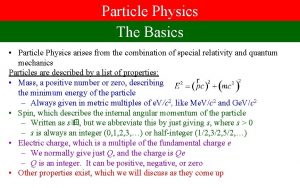Symmetry and Symmetry Violation in Particle Physics Lecture





































































- Slides: 69

Symmetry and Symmetry Violation 对称 in Particle Physics 违反 Lecture 3 March 21, 2008

Summary Lecture 2 • Antimatter predicted by Dirac & discovered by Chao & Anderson – 1933 Nobel prize Dirac – 1936 Nobel prize Anderson (but not Chao) • Electron & positron have opposite parity • Charge “reversal” Charge “conjugation” – Particle Antiparticle (not just charge) • C=+1 even # of g’s; C=-1 odd # of g’s • p and K mesons = qq with L=0, S=0 & P=-1

Summary Lecture 2 (pg 2) • t+ = p+p+p- & q+ p+p 0 puzzle led Lee & Yang to question L-R symmetry of nature • C. S. Wu discovered P viol. in Co 60 Ni 60 e-n – 1957 Nobel Prize to Lee & Yang (but not Wu) • t+ and q+ are the same particle, the K+ meson • C & P violation differences seen in m-/m+ decay – But CP seems okay • Large matter vs antimatter asymmetry in the present-day Universe implies CP is violated. • K 0 transitions possible @ 2 nd-order W. I.

C, P Reminder & CP for p and K mesons Particle P C CP |p+ |p 0 -1 -1 +|p- +|p 0 -|p- -|p 0 |p- -1 +|p+ -|p+ |K+ |K 0 -1 -1 -1 +|K- -|K 0 +|K+ -|K- +|K 0 |K- -1 +|K 0 -|K+

My tentative plan for this class is as follows: Lecture 1. Definition of symmetry, why they are important in physics. Symmetries of the laws of nature. Relation of symmetry and conservation laws. Discrete symmetries C, P & T. Violation of parity (P) in beta-decay Lecture 2. Antimatter, and matter-antimatter symmetry. Quark content of hadrons & discrete symmetries of hadrons. Violation of parity (P) and charge conjugation (C ) symmetry in beta-decay Particleantiparticle mixing. Lecture 3. K 0 mixing. CP violation in K decay. Difficulties with incorporating CP violation into a physics theory. KM 6 -quark mo CP violation. Role of B mesons in theory Lecture 4. Studying CP violation in the B meson system. Experimental techniques and results. What is left for the future. Lecture 5. Exam

Discovery of CP violation in the neutral K meson system outline • Neutral K meson decay mechanisms • K 0 – K 0 mixing KS and KL mesons • Discovery of KL p+p • CP violation in KL p+e-n/p-e+n decays • “Direct” CP violation in KL pp decays

K 0 p+p- decays via weak interaction - p d K 0 d s u DS=-1 W. I. W+ d u p+

K 0 also decays to p+p+ p d K 0 d S u DS=1 W. I. W- u d p-

K 0 possible as a 2 nd order weak interaction process |DS|=2 K 0 p+ d u d S W+ W. I. W- s u p- d d K 0 This is a so-called “long-range” process. It occurs on a size scale determined by the p mesons: ~ 10 -15 m 1 fermi

K 0 in short-range quark |DS|=2 W. I. S u c WK 0 d t W. I. d W+ W. I. u c K 0 s t This is a so-called “short-range” process. It occurs on a size scale determined by the t-quark: ~ 10 -18 m 10 -3 fermi

What happens when two identical systems are coupled? Energy transfers back-and-forth between the two oscillators

Steady-state “normal modes”

. . Shrodinger Equation: H Y = EY H Y Y If CP symmetry holds:

Eigenvalues and Eigenstates 特征值 Find the eigenvalues and eigenvectors for: Answer Homework: Please check that these answers are correct

In standard (textbook) notation

If CP symmetry is good:

CP of K 1 and K 2 Recall: 1 + = P C CP = -1

K 1 decays CP= +1 K 1 + p p ? OK CP= (-1)x(-1) = +1 CP +1 K 1 p + p - p 0? CP = (-1)x(-1) = -1 NG

K 2 decays CP= -1 K 2 + p p ? NG CP= (-1)x(-1) = +1 CP -1 K 2 p + p - p 0? CP = (-1)x(-1) = -1 OK

K 1 & K 2 lifetimes K 2 + p 相空� 0 p p has little phase space QK 2 = MK – 3 Mp 80 Me. V K 1 p + p - has more phase space QK 1 = MK – 2 Mp 215 Me. V Easier for K 1 to decay t. K 1<<t. K 2

1956: Search for long-lived K 0 Brookhaven-Columbia Expt

Can you see it?

KS & KL mesons Two neutral K mesons were discovered: K S p +p - t. KS 0. 1 nanosecs ( 10 -10 s) 500 x bigger K L p +p -p 0 t. KS 50 nanosecs ( 5 x 10 -8 s) (Are they the CP eigenstates K 1 and K 2? )

KL & KS mesons in e+e- annihilation p. S = 110 Me. V <l> = 6 mm e+ p+ 510 Me. V p. L = 110 Me. V <l> = 3. 4 m p 0 p- KL = K-long KS = K-short p+ p- f 510 Me. V e- f = ss M(f) = 1020 Me. V

KLOE Experiment in Italy KL 2 m KS In this event the KL only travels ~1 m before it decays

Usually, the KL traverses to entire 2 m radius of the drift chamber “crash” KKL L“crash” b= 0. 22 (TOF) 2 m K S p -e +n KS

Neutral K mesons “Basis” sets These have a well defined quark structure K 1 -K 2 K 0 -K 0 Flavor States CP eigenstates These are the Particles that exist in Nature KS-KL Mass eigenstsate are these the same?

Does KS=K 1 & KL=K 2? (i. e. is CP conserved? ) These are the particles that are observed in nature express them in terms of K 1 and K 2:

inv er t

e If CV is conserved: e=0, KS=K 1 & KL=K 2

Does KL + p p ? Remember, p+p- has CP=+1 Forbidden(? ) |e|2 =0 if CP is conserved

Christenson-Cronin-Fitch-Turlay Experiment (1964) p+ KL p-

p+p- “invariant mass” M(p+p-)<M(KL) M(p+p-)=M(KL) KL p+ |e|2 = 4 x 10 -6 small, but not 0 q p- p+ M(p+p-)>M(KL) cosq

CP is violated!! James Cronin Val Fitch 1980 Nobel Prize for Physics No prizes for Christenson or Turlay

特定 Flavor-non specific K 0 (K 0) decays Decays that are equally likely for K 0 and K 0 0 K + p p K 0 p + p 0 K + p 0 pp K 0 p + p - p 0 çIf you see p+p-, you don’t know if it was from a K 0 or a K 0 çSame for p+p-p 0, (& p 0 p 0 p 0)

特定 Flavor specific 0 K 0 (K ) decays Decays that can only come from a K 0 or K 0, but not both d + d p p u d K 0 W. I. s W+ DS=-1 DQ=-1 0 K p + e n If you see p-e+n, you know it must be from a K 0, not K 0 n K 0 s W. I. W- e+ Rule: only DS=DQ DS=+1 DQ=+1 n e- K 0 p + e - n If you see p+e-n, you know it must be from a K 0, not K 0

K 0 & K 0 in terms of KS & KL inv er t

Start with a K 0 at t=0 KS & KL have different t-dependence using and

Similarly:

0 0 K K Expt NA 48 (CERN) Oscillations GS>>GL (GS 500 x. GL) K 0 CP is violated in KL p+e-n/p-e+n decays t=t/g (“proper time”)

Search for direct CPV in KL pp In 2002, after 20 yr searches, NA 48 (CERN) & KTe. V (Fermilab) found direct |DS|=1 CPV in K 2 pp Is this true? Can there be a “direct” CP violation in |DS|=1 K 2 pp? Forbidden(? ) CP violation from |DS|=2 transition Mass Matrix = e’ 1. 6 x 10 -3 Small, but establishes existence of “direct” |DS|=1 CP violation. x e

CPV in neutral K meson system summary • Neutral K mesons mix: K 0 • CP is violated in the K 0 -K 0 mass-mixing matrix – scale e 2 x 10 -3 • CPV is seen in flavor non-specific & flavor specific modes – KL pp (CPV e 2 4 x 10 -6) – K L p + e -n / p-e+n (CPV e = 2 x 10 -3) • Direct CP is seen in KL pp decays – scale = e’ = 1. 6 x 10 -3 e

CP is violated in the Weak Interactions Observation of both Mass-Matrix CPV (|DS|=2) & direct CPV (|DS|=1) rule out theories where CPV comes from a previously unknown “fifth” force characterized by |DS|=2

C P and the forces of Nature Slide from last weak Force Gravity Electro-magnetic Strong-nuclear Weak-Interaction C P CP √ √ √ ╳ √ √ √ OK? ╳

Next: • How are CP-violating asymmetries generated in QM? • How does CP violation fit into the Standard Model for particle physics? – Brief review of flavor mixing/GIM-mechanism – Kobayashi 6 -quark model

Generating CPV asymmetries in QM

CP: matter antimatter “charge” CP operator: CP( q g q W )= some basic process q’ g* q W† mirror For CPV: g g* (charge has to be complex)

QM: processes go as |A|2 • Phases tend to cancel out in rate calculations g*g gg* 2 2 q’ g* = q q J J† mirror even for g* = g (i. e with CPV) matter- antimatter symmetry is ~“automatic”

Phase measurements in QM: need interference 干� • need a process with 2 competing mechanisms: e s a e h p gl an A & Beif: |A+B|2=|A|2+|B|2+2|A|B|cosf • Amplitudes should have similar magnitudes: 2|A|B|cosf |A|2+|B|2 Relative size of the interference effect if |A|>>|B| 2|B| |A| cosf Small number

Even this doesn’t work for CPV!! A+B f B A A+B A |A+B| = f B |A+B| l! l i t s matter antimatter symmetric

need a “common phase” d between A & B 合用 same sign eg A=real: B = |B|eid+if A+B B A & B = |B|eid-if f A+B d f d A |A+B| = |A+B| matter antimatter difference B

CP violating asymmetries in QM • Even if CP is violated, generating matter-antimatter differences is hard – need a CP-violating phase (f) – need 2 (or more) interfering amplitudes – + a non-zero “common” phase (d) (often called a “strong” phase)

Common and weak phases “Common” (strong) phase (d): same sign for matter & antimatter CP conserving Weak phase (f): opposite sign for matter & antimatter CP violating B = |B|eid-if |B|eid+if A+B B f d A+B A f d B

How does CPV fit into the Standard model? Clue: CPV is seen in strangeness-changing weak decays. It must have something to do with flavor-changing Weak Interactions

Flavor mixing & CP Violation

Brief review of weak int’s in the 3 -quark era 1964 --1974 3 quarks: q=+2/3 |DS|=1 q=-1/3 s 4 leptons: Weak interactions

Problems Problem 1: Different weak interaction “charges” for leptons & hadrons: Fermi Constant d u Gd 0. 98 GF d n m- Gd u GF Kp nm s s u Gs 0. 21 GF Gs u p 0

Cabibbo’s sol’n: flavor mixing Weak Int flavor state Flavor mass eigenstates d = a d + b s GF d’ u = W- a=cosqc=0. 98 a. GF d b=sinqc=0. 21 u + W- b. GF s u W- Unitarity: |a|2 + |b|2 = 1 a=cos qc; b = sin qc qc=“Cabibbo angle”

Missing neutral currents Problem 2: no flavor-changing Discovered “neutral currents” seen. At CERN GN d, u s d, u K- flavor-preserving neutral currents (e. g. n. N n. X) are allowed d pflavor-changing neutral currents (e. g. K p l+l-) are strongly supressed

GIM sol’n: Introduce 4 th quark 2 quark doublets: charmed quark Weak eigenstates Mass eigenstates

d’ & s’ are mixed d & s 4 -quark flavor-mixing matrix Weak eigenstates Mass eigenstates

Mixing matrix must be Unitary UU† = 1 |a|2 + |b|2 = 1 & a*b - ab* =0

Charged currents (u-quark) |DS|=1 a. GF d(s) GF u(c) W- modified by b. GF s(d) a GF u(c) W- modified by b

Charged currents (c-quark) |DC|=1 |DS|=1 |DC|=1 |DS|=0 -b. GF d GF c W- modified by s b a. GF GF c W- modified by a

Flavor preserving Neutral Current 1 = |a|2+|b| 2 G d, (s) =1 OK d, (S) N Z 0 =0 =0 =1 =1 From Unitarity

Flavor changing Neutral Current =0 G (a*b+ba*) N d(s) s(d) Z 0 =0 =1 =0 From FCNC forbidden by Unitarity GIMMechanism

GIM Mechanism FCNC forbidden by Unitarity if quarks come in pairs of 2 GIM: Glashow Iliopoulis Maiani Glashow won 1979 Physics Nobel prize No prize for Iliopoulis & Maiani

Next Friday: Incorporating CPV into flavor mixing

Summary Lecture 3 • CP is violated Weak-Interactions – Mass-matrix induced; scale e 2 x 10 -3 – Direct CPV; scale = e’ = 1. 6 x 10 -3 e • Observing CPV requires: – Two interfering amplitudes – One with a CP-violating weak phase – Another “common” or “strong” phase • In the W. I. , the d and s quark mix d’ & s’ – d’ =cosqcd +sinq s; s’ =-sinqcd +cosqcs – qc 120 is the “Cabibbo angle • If all quarks are in pairs, FCNC = 0 by Unitarity – (GIM Mechanism)
 01:640:244 lecture notes - lecture 15: plat, idah, farad
01:640:244 lecture notes - lecture 15: plat, idah, farad Pmt particle physics
Pmt particle physics Modern particle physics mark thomson
Modern particle physics mark thomson Particle physics
Particle physics Particle physics practice quiz
Particle physics practice quiz Particle physics timeline
Particle physics timeline Monte carlo simulation particle physics
Monte carlo simulation particle physics Cern particle physics
Cern particle physics European laboratory for particle physics
European laboratory for particle physics Cern particle physics
Cern particle physics Particle physics
Particle physics Form factor particle physics
Form factor particle physics International masterclasses hands on particle physics
International masterclasses hands on particle physics Classical mechanics
Classical mechanics Physics 101 lecture notes pdf
Physics 101 lecture notes pdf Phy101 lecture 1
Phy101 lecture 1 Physics 101 lecture notes pdf
Physics 101 lecture notes pdf Wave motion definition
Wave motion definition Atmospheric physics lecture notes
Atmospheric physics lecture notes Pauli exclusion principle
Pauli exclusion principle Cp symmetry
Cp symmetry Ferpa violations
Ferpa violations Positive violation valence
Positive violation valence It is the recognized violation of cultural norms
It is the recognized violation of cultural norms Violation valence
Violation valence Danielles law
Danielles law Virginia probation violation sentencing guidelines
Virginia probation violation sentencing guidelines When employees resort to unauthorized strike in violation
When employees resort to unauthorized strike in violation Cultural deviant
Cultural deviant Case management information system
Case management information system Judge muth east stroudsburg pa
Judge muth east stroudsburg pa Lsr violation
Lsr violation Sussex pledge
Sussex pledge Altering a driver's license may result in
Altering a driver's license may result in Vcs
Vcs Cp-violation
Cp-violation Teachers ethics
Teachers ethics Honor violation probation tamu
Honor violation probation tamu Cp-violation
Cp-violation Ra9003
Ra9003 Type of violation
Type of violation Kaon cp violation
Kaon cp violation Code cave utilization
Code cave utilization Pauli exclusion principle violation
Pauli exclusion principle violation Aggie code of honor
Aggie code of honor Traffic control violation sap
Traffic control violation sap Mosaic plagiarism example
Mosaic plagiarism example Ferpa violation
Ferpa violation Ferpa violation
Ferpa violation Info 2950
Info 2950 Order of rotational symmetry
Order of rotational symmetry Why does it happen
Why does it happen University physics with modern physics fifteenth edition
University physics with modern physics fifteenth edition Ib physics ia samples
Ib physics ia samples Symmetry in respect to the origin
Symmetry in respect to the origin Difference between particle and rigid body
Difference between particle and rigid body Particle equilibrium in 2d and 3d engineering mechanics
Particle equilibrium in 2d and 3d engineering mechanics Kinetics of a particle force and acceleration
Kinetics of a particle force and acceleration Kinetics of a particle: impulse and momentum
Kinetics of a particle: impulse and momentum Youtube https //www.youtube.com/watch v=vnp84pn0mjq
Youtube https //www.youtube.com/watch v=vnp84pn0mjq Particle movement in solids liquids and gases
Particle movement in solids liquids and gases Dissolving particle model
Dissolving particle model Solid heat
Solid heat Particle removal wet etch filters
Particle removal wet etch filters Wave particle duality questions
Wave particle duality questions Wave-particle duality
Wave-particle duality Andreasen apparatus consists of hydrometer
Andreasen apparatus consists of hydrometer Alpha particle symbol
Alpha particle symbol What is the particle theory of matter
What is the particle theory of matter Particle model of electricity
Particle model of electricity

